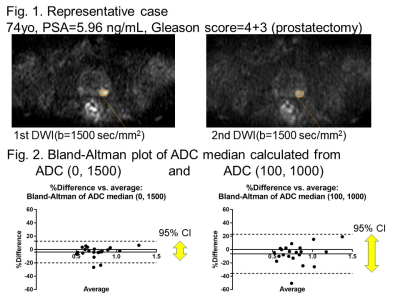Masamitsu Hatakenaka1, Naomi Koyama1, Naoya Yama1, Maki Onodera1, Koichi Onodera1, Yurina Onuma1, Ryo Taguchi1, and Mitsuhiro Nakanishi2
1Diagnostic Radiology, Sapporo Medical University, Sapporo, Japan, 2Radiology and Nuclear Medicine, Sapporo Medical University Hospital, Sapporo, Japan
Synopsis
In prostate cancer, although calculating ADC with b-value
combination of 50-100 and 800-1000 sec/mm2 is recommended by PI-RADS
ver. 2, ADC calculated with b-values of 0 and 1500 sec/mm2 may be superior with respect
to repeatability and correlation with cancer aggressiveness.
Introduction
PI-RADS
ver.2 recommends that DWI should include ADC map and high b-value images
(b-value≥1400 sec/mm2), and if only two b-values can be acquired, it is preferred that
the lowest b-value should be set at 50-100 sec/mm2 and the highest at 800-1000 sec/mm2.1
This recommendation sounds reasonable but has yet to be
assured sufficiently regarding repeatability and
correlation with cancer aggressiveness. The present study was investigated to evaluate
what combination of
b-values is appropriate for calculating ADC with respect to ADC
repeatability and correlation with Gleason score.Methods
Consecutive
20 patients with histologically confirmed prostate cancer (21 lesions) who underwent
pelvic MRI using whole-body clinical MRI system (3T of Ingenia, Philips Medical
Systems, Best, the Netherlands) to evaluate prostate in our hospital from July
to October in 2017 were included. All patients gave informed consent to
participate in the study. Two sequential free-breathing single shot
diffusion-weighted spin-echo echo-planar imaging (DWI) with
b-values of 0, 100, 1000 and 1500 sec/mm2 and
identical positioning were obtained during examination. The regions of interest (ROI) were assigned at 21 cancers
on the 1st DWI and pasted them onto the 2nd DWI holding
their size and location. Slight visual adjustment of the ROI on the 2nd
DWI was performed when two observers considered it is necessary to cope with
minimal distortions and/or movements. Each voxel ADC was calculated by fitting signal
intensity of each voxel into mono-exponential curve. ADCs calculated from
several combinations of b-values were expresses as follows: ADC (0, 1000), ADC
(0, 1500), ADC (100, 1000), ADC (100, 1500) and ADC (1000, 1500) were calculated
from b-values of 0 and 1000 sec/mm2, 0 and 1500 sec/mm2, 100
and 1000 sec/mm2, 100 and 1500 sec/mm2 and 1000 and 1500
sec/mm2, respectively. The repeatability of ADC histogram metrics of 10% (ADC 10%), 25% (ADC 25%), median (ADC median), mean
(ADC mean), 75% (ADC 75%), 90% (ADC 90%), skewness (ADC skewness) and kurtosis (ADC
kurtosis) of voxel-wise ADC within ROI was evaluated using intraclass
correlation coefficient (ICC), Bland-Altman plot and within-subject coefficient
of variance. The correlation between ADC and Gleason score was also analyzed
with Spearman’s rank-order correlation. In cases in
which radiotherapy (IMRT) was selected and only prostate
biopsy, not prostatectomy, was performed,
representative and maximum Gleason scores were used separately. In cases
prostatectomy was performed, Gleason score was used for both representative
and maximum Gleason scores. p<0.05 was considered statistically significant.Results
ADC
(0, 1500) showed the highest repeatability in all ADC histogram metrics except ADC 10%. ADC skewness and
kurtosis showed very low repeatability irrespective of b-value combinations. Therefore, Spearman’s rank-order correlation test was not
performed for ADC skewness and kurtosis. Significant correlation with
maximum Gleason score was obtained in ADC median and mean calculated from ADC
(0, 1500) and ADC 25% calculated from ADC (0, 1000), respectively. Representative
Gleason score showed no significant correlation with ADC histogram metrics. ADC histogram metrics
calculated from ADC (100, 1000) recommended by PI-RADS
ver. 2 showed lower repeatability compared with those calculated from ADC (0, 1500) and no significant
correlation with Gleason score. A representative case was shown in Fig. 1. Details
of the results were summarized in Table 1. Conclusion
ADC
calculated with b-values of 0 and 1500 sec/mm2 is considered appropriate
with respect to ADC repeatability and
correlation with Gleason score when b-values of DWI were restricted to only two values due to clinical conditions.Acknowledgements
No acknowledgement found.References
1.
PI-RADS Prostate Imaging - Reporting and Data System: 2015, Version 2. Weinreb
JC, Barentsz JO, Choyke PL, Cornud F, Haider MA, Macura KJ, Margolis D, Schnall
MD, Shtern F, Tempany CM, Thoeny HC, Verma S. Eur Urol. 2016 Jan;69(1):16-40.

